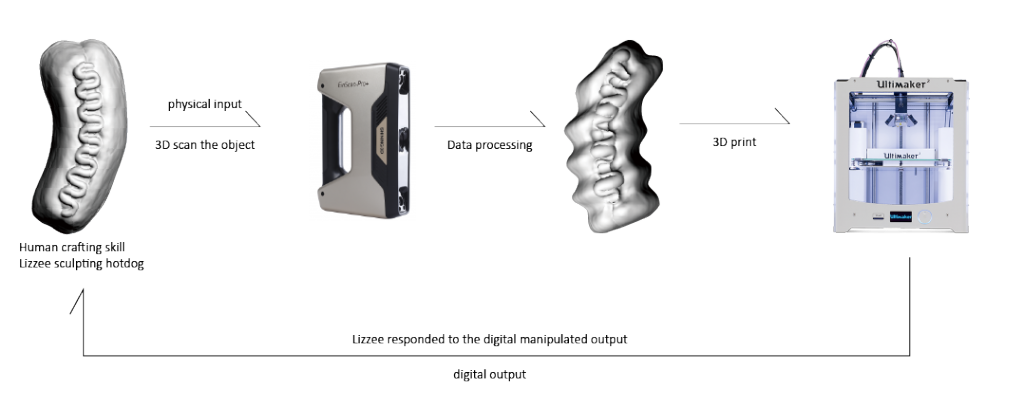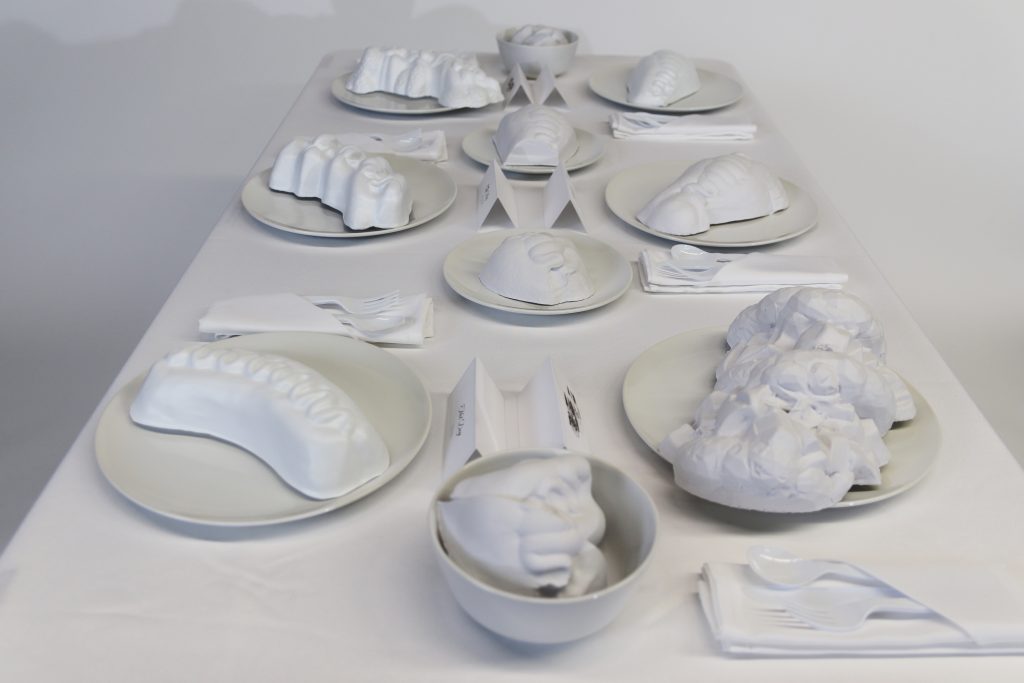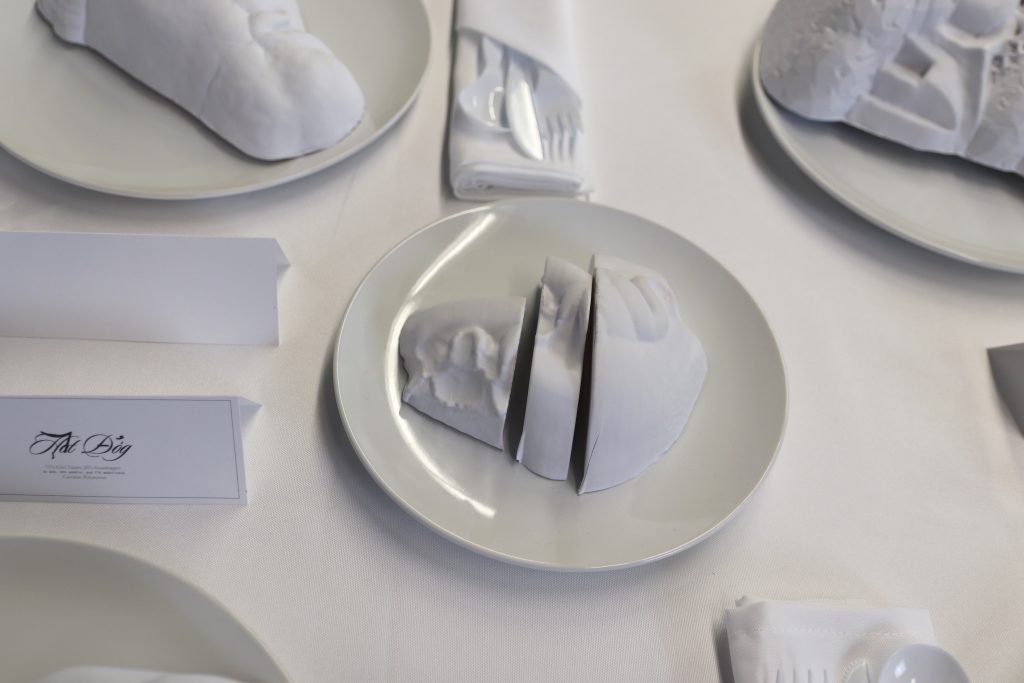By: Yi-Chin Lee, Matt Prindible, and Lizzee Solomon
Submission Date: Wednesday, May 1, 2019
Abstract(ion)
The capacity to explore physical artistic work in abstraction through digital transformation and fabrication is conceptually simple, but technically challenging. Our “machine-in-the-loop” workflow is comprised of a laser scanner to generate a point cloud of the artist’s sculpture, software to create a watertight mesh of that point cloud, parametric design software to procedurally transform the mesh, a slicing tool for generating toolpaths for severely damaged 3D models, a 3D printer capable of working through tooling errors, and a vacuum form table to prepare the final model. The tool of intervention for our artist was air drying clay and Super Sculpey in addition to some basic sculpting tools. An oven was also involved. We used this workflow to generate a series of machine “responses” to the artist’s sculpture. The artist then created a response this response. And so on. Our goal was to enable to “dialog” between the artist and machine that helped the artist explore unexpected shapes and gestures. Our technical exploration was successful and, based on this functional experimental workflow and a conversation with our artist, our artistic exploration was also successful.
Objectives
The fundamental goal of this project was to demonstrate a function experimental workflow for generating a transformed physical object from original sculpture—the technical underpinnings rather than the artistic expression. Because of the recursive nature of the workflow, it should also be highly repeatable and somewhat reliable. Working with an artist, however, afforded the opportunity to discuss and critique the value of this workflow as part of her artistic practice. To do this, we needed to generate a form of a high enough artistic value.
Implementation
Given the experimental nature of our workflow, the primary driver of design choices was “Whatever It Takes.” Most of the software and hardware used for this project was not meant to be used this way and, as in the case of most digital fabrication, aesthetic was sacrificed in order to generate a physical form. That being said, in order to have a useful conversation about the value of this workflow in our artist’s practice, we had to generate forms of a compelling artistic value.
The first step in the process was evaluating tools for volumetric scanning of the original sculpture. We tested photogrammetry methods with simple mobile phone cameras, a Microsoft Kinect, and a 3D laser scanner. We picked the EinScan laser scanner not only for its precision, but because it also included the software needed to generate a watertight model from a point cloud.

We ultimately used Grasshopper for Rhino to procedurally transform our mesh because of its control over parameterization—we knew early on that we wanted to heavily influence the forms the machine could generate (playing the role of a human artificial intelligence). But we also played with solid modeling programs like Fusion 360 and datamoshing techniques for glitch art.
For pre-processing the generated model, we used Meshmixer, Simplify3D, and Magics. The pre-processor and slicer used depended on its ability to use the models we generated, which were often non manifold or riddled with thousands of inverted normals and naked edges.
During the printing process, we had a chance to test every 3D printer on CMU’s campus. Although IDeATe’s Stratasys printers had a best finish for the cost, the small build volumes made production difficult. And although dFab’s binder jetting printer and the School of Design’s Formlabs 2 had the best finishes overall, they were incredibly expensive (although we’d still like to explore the use of binder jetting for models impossible to print via extrusion). Ultimately, dFab’s Ultimakers with PLA became the workhorse for our projects. The finish and timing was decent (with most models taking about 30 hours to print), but most importantly, the build volume gave us the sizes we needed.
Our artist used either air dry clay (which did not adhere well to the PLA surface) or Super Sculpey for her response (which baked well in the oven with the PLA and no additional slumping). Differential expansion between the materials was a problem (Super Sculpey shrinks quite a bit in the oven, PLA does not).
Hybrid Workflow

Hotdog Collection

Dinner Table Setting




Contribution
These was an equal effort by both. This is the kind of project that demands someone at the computer driving the mouse and keyboard. And someone in the next seat cheering them on. And switching back and forth as we worked through all the technical hurdles.
Outcomes
The biggest failures in our project were build failures during 3D printing (mostly for the lost time) and unrepairable meshes from our procedural transformation (which kept us from printing some of the crazier forms). However, these limitations did not affect us from seeing a distinct change in the artist’s sculpting style (often reciprocating the “crystalline” geometry generated).
Precedent and cited work
Three pieces of existing work were referenced early and often throughout the process. Robin Sloan’s Flip Flop, Navaneeth R Nair’s Wave-form, and Geoffrey Mann’s Cross-fire. As well as a million YouTube tutorials.

https://www.youtube.com/watch?time_continue=11&v=otmmihz3Gq8